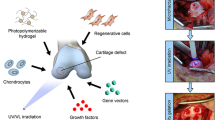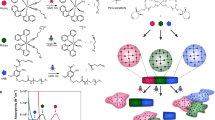Abstract
This article is based on the Outstanding Young Investigator Award presentation given by Kristi S. Anseth at the 2001 MRS Spring Meeting on April 17, 2001, in San Francisco. Anseth was recognized for “innovative work in polymeric biomaterials for drug delivery, bone and cartilage repair, and tissue engineering, and for outstanding leadership potential in this interdisciplinary field of materials research.”
Photopolymerization provides many advantages as a technique for the fabrication of biomaterials. Temporal and spatial control, along with the diversity in material properties found with photopolymerizable materials, are advantageous in the biomaterials industry. For instance, multifunctional anhydride monomers form highly cross-linked surface-eroding networks directly in bone defects. These networks have good mechanical properties that are maintained with degradation and have the potential to restore tissue-like properties to bone during the healing process. Additionally, cartilage-forming cells photoencapsulated in hydrogel networks secrete an extracellular matrix as the hydrogel is resorbed and may provide a treatment alternative for cartilage defects that do not heal spontaneously. Finally, transdermal polymerization (photopolymerization through the skin) of multifunctional monomers is a noninvasive technique that is being developed for tissue regeneration and wound-healing applications.
Similar content being viewed by others
References
C. Decker, J. Coating Technol. 59 (1987) p. 97.
K.S. Anseth, S.M. Newman, and C.N. Bowman, Adv. Polym. Sci. 122 (1995) p. 177.
J. Hill-West, S. Chowdhury, A. Sawhney, C. Pathak, R. Dunn, and J. Hubbell, Obstet. Gynecol. 83 (1994) p. 59.
H. Brem, K.A. Walter, and R. Langer, Eur. J. Pharm. Biopharm. 39 (1993) p. 2
D. Svaldi Muggli, A.K. Burkoth, and K.S. Anseth, J. Biomed. Mater. Res. 46 (1999) p. 271.
J. Kloosterboer, Adv. Polym. Sci. 84 (1988) p. 1.
D. Svaldi Muggli, A.K. Burkoth, S.A. Keyser, H.R. Lee, and K.S. Anseth, Macromolecules 31 (1998) p. 4120.
K.S. Anseth, V.R. Shastri, and R. Langer, Nat. Biotech. 17 (1999) p. 156.
J.A. Burdick, A.J. Peterson, and K.S. Anseth, Biomaterials 22 (2001) p. 1779.
A.T. Metters, K.S. Anseth, and C.N. Bowman, Polymer 41 (2000) p. 3993.
P. Martens, A.T. Metters, C.N. Bowman, and K.S. Anseth, Soc. Biomater. Trans. 24 (2001) p. 312.
S.J. Bryant and K.S. Anseth, J. Biomed. Mater. Res. 59 (2002) p. 63.
S.J. Bryant and K.S. Anseth, “Controlling the Spatial Distribution of ECM Components in Degradable PEG Hydrogels for Tissue Engineering Cartilage,” J. Biomed. Mater. Res. (2001) in press.
S.J. Bryant and K.S. Anseth, Soc. Biomater. Trans. 24 (2001) p. 77.
S.J. Bryant, C.R. Nuttelman, and K.S. Anseth, J. Biomater. Sci. Polym. Ed. 11 (2000) p. 439.
A.T. Metters, K.S. Anseth, and C.N. Bowman, J. Phys. Chem. B 104 (2000) p. 7043.
C.G. Armstrong and V.C. Mow, J. Bone Joint Surg. Am. 64 (1982) p. 88.
B. Kladny, P. Martus, K.H. Schiwy-Bochat, G. Weseloh, and B. Swoboda, Int. Orthop. 23 (1999) p. 264.
S.J. Bryant and K.S. Anseth, Biomaterials 22 (2001) p. 619.
J.E. Elisseeff, K. Anseth, D. Sims, M. Randolph, and R. Langer, Proc. Natl. Acad. Sci. U.S.A. 96 (1999) p. 3104.
R. Woodburne and W. Burkel, Essentials of Human Anatomy (Oxford Press, Boca Raton, FL, 1994).
D.C. Svaldi Muggli, M.S. dissertation, University of Colorado, 1997.
S. Bryant, P. Martens, J. Elisseeff, M. Randolph, R. Langer, and K. Anseth, in Chemical and Physical Networks: Formation and Control of Properties, The Wiley Polymer Networks Group Review Series, Vol. 2, edited by B.T. Stokke and A. Elgsaeter (Wiley, New York, 1999) p. 395.
M.M. Urist, W.A. Maddox, J.E. Kennedy, and C.M. Balch, Cancer 51 (1988) p. 2152
W.H. Lindsey, T.M. Masterson, W.D. Spotnitz, M.C. Wilhelm, and R.F. Morgan, Arch. Surg. 125 (1990) p. 305.
Rights and permissions
About this article
Cite this article
Anseth, K.S., Burdick, J.A. New Directions in Photopolymerizable Biomaterials. MRS Bulletin 27, 130–136 (2002). https://doi.org/10.1557/mrs2002.49
Published:
Issue Date:
DOI: https://doi.org/10.1557/mrs2002.49




